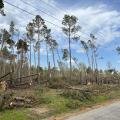Economic Effects of Low-Weight Hauling Ordinances on Forest Landowner Income in Mississippi: The Webster County Example
In recent years, many local disputes have arisen between County Supervisors and logging contractors over highway and bridge usage and the weight of loaded log trucks. The problem typically involves trying to balance the Supervisor's concern for road damage and the logger's need to have reasonable access to the timber to be harvested. These disputes can sometimes escalate to the point where County Boards of Supervisors pass prohibitive ordinances or regulations that severely limit the amount of weight a logger can legally carry over the roads in the county.
These weight-limit regulations are usually designed by Supervisors to punish loggers, but they often have a significant, negative economic impact on local forest landowners instead, because timber buyers react by lowering stumpage prices to accommodate increased transportation costs. Or they may completely stop the purchase of standing timber in the county.
In the Fall of 1995, such a dispute developed in Webster County, Mississippi. In reaction to a logging operation that a Supervisor thought was running overweight trucks, the Webster County Board of Supervisors passed an ordinance that limited total log truck weights in the county to 40,000 pounds. The allowable weight before the ordinance was 80,000 pounds.
Some members of the forestry community requested that an estimate of the economic impact of the ordinance on forest landowner income in Webster County be developed. The answer was that the ordinance increased transportation costs for the loggers 86 percent and that translated into a 21 percent decrease in the stumpage price that a mill could afford to pay on standing timber in Webster County under the low-weight ordinance. Based on the forest harvest value in Webster County in 1994, forest landowner timber sale income under the ordinance would decline $1,099,973.
This effect was significant. When the local forest landowner association members realized the negative impact this ordinance would have on their timber sale income, they spoke to their Supervisors and the ordinance was relaxed. Subsequently, the dispute with the logger was also resolved.
This example from Webster County, Mississippi shows the importance of local understanding of forestry's importance in the local economy. Economic information, such as harvest volumes and average prices, is useful to resolve disputes by showing the relative economic impacts of local policies on loggers and forest owners. Hopefully, this example will help other counties understand the relative impact that low-weight ordinances can have on their local economies. In 1994, timber was either the most valuable or second most valuable agricultural crop in 68 of 82 counties.
Attached are two summary pages for Webster County, Mississippi in 1995. One page is a profile of Forestry in Webster County including acres of forest, forest acres by type, ownership profile, and economic importance data from 1992 to 1994. Timber values represented from 35 to 41 percent of total agricultural production value in Webster County. The second page shows the analysis and answers the question "What will be the effect of the changed road and bridge weight limit on Webster County Forestry?" Hopefully, this example will help other counties to gauge the economic impacts such regulations may have on the forest landowners in their own locality and be helpful to educate local officials of he potential impacts of ht e ordinances they impose.
For more information contact Extension Forestry, Department of Forestry, Box 9681, Mississippi State, MS 39762. Phone: 662-325-3150
What Will Be the Effect of the Changed Road and Bridge Weight Limit on Webster County Forestry?
Assume a atypical timber tract that has 50,000 board feet of sawtimber on it.
Under an 80,000 pound load weight limit, a typical log truck (average tractor/trailer weight 25,000 pounds) could haul a load weighing about 55,000 pounds. Using an average weight of 16,000 pounds of pine logs to make 1 MBF of lumber, the average load of logs will be 3.4 MBF. This means that it will take (50/3.4 = 14.7) about 15 loads of logs to harvest the tract.
If the weight limit is lowered to 40,000 pounds, each truck's load capacity will fall from 55,000 pounds or 3.4 MBF to 15,000 pounds or (15/8 = 1.8) 1.8 MBF. This will require (50/1.8 = 27.7) 28 loads to harvest the tract. This nearly doubles the transportation costs for harvesting Webster County timber.
Assume a 50 mile haul distance, $1.15/mile to run the tractor/trailer, and $12.00/hour for the driver. A load will take about one hour each way. So the transportation costs per load will be ($1.15 x 100 = $115 for the truck, 2 x $12 = $24 for the driver) $139. This would translate to (139 x 15 = $2,085) $2,085 at the 80,000 pound weight limit and ($139 x 28 = $3,892) $3,892 at the 40,000 pound weight limit. Hence, the new, lower weight limit increases hauling costs by ($3,892 - $2,085 = $1,807/2,085 = .866 x 100 = 86%) 86%!
Since lumber prices and harvesting costs will remain fixed and transportation costs will increase, the only way for a buyer to justify purchasing the tract would be to pay less for the standing timber. The average pine sawtimber standing price for pine sawlogs in North Mississippi during July/August, 1995 was $298/MBF, Doyle. Let's say the price is $300/MBF. During the same period average, delivered log prices were $371/MBF, D. This means that harvesting and transportation costs were about $70 to $80/MBF. Presumably this reflects the normal 80,000 pound load limit on MS roads. If transportation costs go up 86% as under the Webster County ordinance, it would have to be absorbed by the lowering of stumpage. Hence, standing timber prices would fall ($75 x .86 = $64.50) about $64.50 at a minimum. This translates to about a 21% cut in the stumpage price a mill could pay to landowners, at best. At worst, timber buyers may not purchase timber at all in Webster County when it could be bought in adjoining counties without restriction.
- This development would have caused landowner's timber income in the county in 1994 to fall from $5,237,967 to $4,137,994, a drop of $1,099,973. The answer to the question is that the new weight limit will likely be a significant, negative effect on Webster County forest landowners.
Publications
News
STARKVILLE, Miss. -- Agriculture and forestry are Mississippi’s top industries, but their significance to the state’s economy extends beyond the revenue they generate on their own.
RAYMOND, Miss. -- Mississippi’s 2023 timber harvest is expected to set a record for the 21st century. “We are on pace to exceed 36 million tons of timber harvested, which would be the highest level we have experienced this century, surpassing the previous high set in 2005 prior to the Great Recession,” said Eric McConnell, an associate professor of forest business at Mississippi State University. The increased harvest helped Mississippi’s forestry industry remain in third place among the state’s agricultural commodities, with an estimated production value of $1.5 billion. That is a 9.6% increase from 2022.



